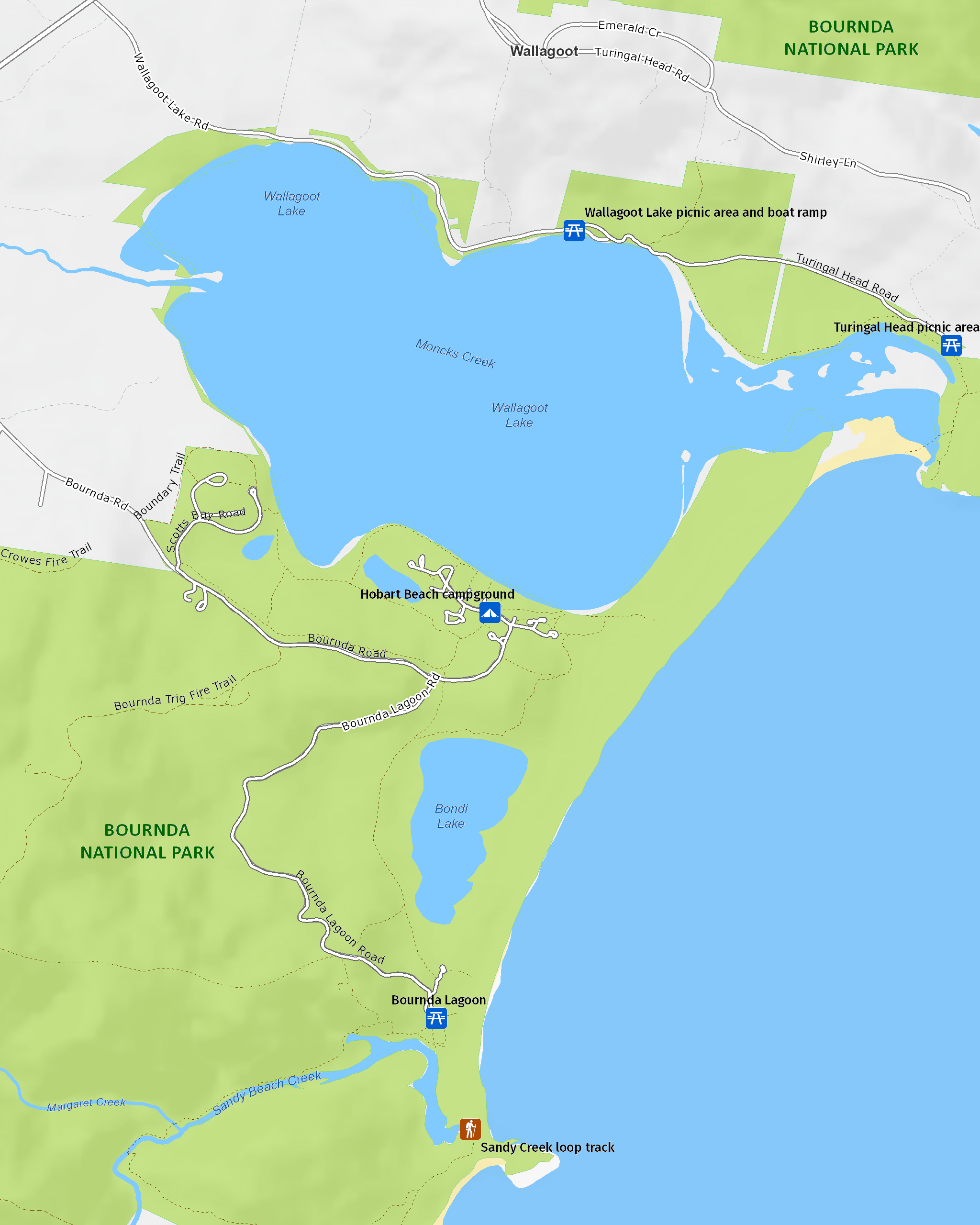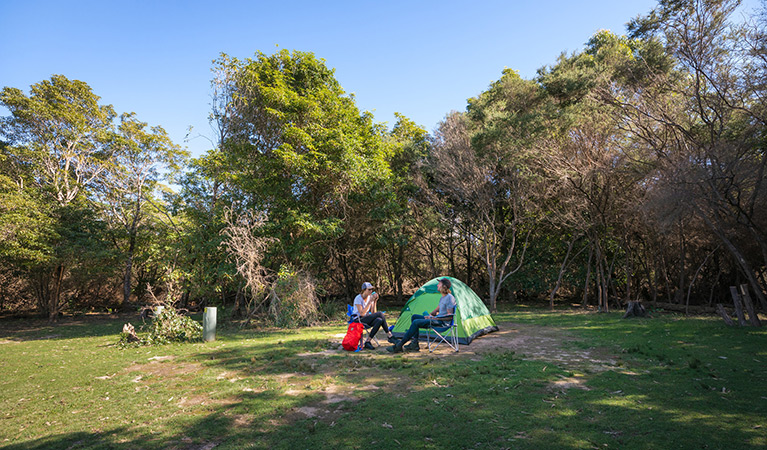Hobart Beach campground
Bournda National Park
Overview
Hobart Beach campground, near Bega, is a perfect coastal holiday offering swimming, fishing, paddling, and walking options for the whole family.
| Number of campsites | 66 |
|---|---|
| Camping type | Tent, Camper trailer site, Caravan site, Camping beside my vehicle |
| Where | 293 Bournda Road, Bournda, NSW, 2548 - in Bournda National Park |
| Facilities | Amenities block, picnic tables, barbecue facilities, carpark, showers, toilets |
| What to bring | Drinking water, cooking water, firewood |
| Entry fees |
Park entry fees are not included in your camping fees. |
| Group bookings | Book up to 40 people or 9 sites online. For larger groups, make a group booking enquiry. |
| Please note |
|
Pack the car with all your favourite outdoor camping equipment and head for the sandy shores of the idyllic Wallagoot Lake. Hobart Beach campground in Bournda National Park on the far south coast is a great destination for a family holiday.
Pitch the tent or park the van beside the shimmering waters fringed with forest. While you might have relaxing in mind, there are loads of activities to keep everyone happy. Spend your days swimming, walking, cycling, fishing and exploring nearby secluded beaches. The peaceful lake is ideal swimming for the little ones, while the northern shores of Wallagoot Lake are excellent for sailing and paddling.
If you’ve spent the day fishing, gather the clan for a relaxing barbecue of your daily catch and recount stories of the one that got away.
Map

Map legend

Local alerts
For the latest updates on fires, closures and other alerts in this area, see https://www.nationalparks.nsw.gov.au/camping-and-accommodation/campgrounds/hobart-beach-campground/local-alerts
Bookings
- National Parks Contact Centre
- 7am to 7pm daily
- 1300 072 757 (13000 PARKS) for the cost of a local call within Australia excluding mobiles
- parks.info@environment.nsw.gov.au
Operated by
- Merimbula office
- Monday to Friday and some weekends during peak holiday periods, 10am to 3pm.
- 02 6495 5000
- npws.sapphirecoast@environment.nsw.gov.au
- 47 Merimbula Drive, cnr Sapphire Coast Drive, Merimbula NSW 2548
Park info
- in Bournda National Park in the South Coast region
Bournda National Park is always open but may have to close at times due to extreme weather or fire danger.
-
Park entry fees:
$8 per vehicle per day. This park uses a self-registration fee collection system, please bring correct change.
Buy annual pass.
Visitor info
All the practical information you need to know about Hobart Beach campground.
Maps and downloads
Learn more
Hobart Beach campground is in Bournda National Park. Here are just some of the reasons why this park is special:
Birdwatchers haven

With around 200 species of birds in the area, Bournda is a birdwatcher's paradise. The estuarine wetlands at the eastern end of Wallagoot Lake provide roosting and feeding areas for a large variety of waders and waterfowl. Keep your eyes out for threatened species like the little tern, hooded plover and pied oystercatcher. Bondi Lake is the largest freshwater lake situated behind coastal dunes in the region, and is another important habitat for waterbirds.
- Bournda Environmental Education Centre Bournda National Park Environmental Education Centre offers school environmental education programs for Kindergarten to Year 12 students. It is located in Bournda National Park, near Tathra.
- Bournda Environmental Education Centre Bournda National Park Environmental Education Centre offers school environmental education programs for Kindergarten to Year 12 students. It is located in Bournda National Park, near Tathra.
- Bournda Lagoon Bournda Lagoon is an ideal spot within Bournda National Park, near North Tura, where kids can swim, fish and go paddling and picnic among the paper barks.
- Kangarutha walking track Kangarutha walking track, in Bournda National Park, is a hiking route with scenic coastal views and birdwatching, picnicking and swimming opportunities along the way.
- Sandy Creek loop track Taking in Bournda Lagoon, Sandy Creek and pockets of dry sclerophyll forest, Sandy Creek loop track is a hike in Bournda National Park on the far South Coast.
Get active

With so much to do, there's no excuse not to get active in Bournda. The beaches and waterways offer a range of options for watersport enthusiasts - waterskiing, boating, paddling, sail boarding, fishing, swimming and surfing. The coastal walk is perfect for hikers and those hoping to spot migrating whales. And for cyclists, the roads throughout the park are an extensive network to navigate on your bike.
- Living Country, living culture Join us for Living Country, living culture – a Stage 1 History excursion in Bournda National Park. In this cross-curricular program, an Aboriginal guide will help students understand the importance of culture and caring for Country.
- Living Country, living culture Join us for Living Country, Living Culture – a Stage 2 History excursion in Bournda National Park. In this cross-curricular program, an Aboriginal guide will help students understand the importance of culture and caring for Country.
- Living Country, living culture Join us for Living Country, living culture – a Stage 3 Geography excursion in Bournda National Park. In this cross-curricular program, an Aboriginal guide will help students understand the importance of culture and caring for Country.
Ships ahoy

There's plenty of fascinating heritage in Bournda, dating back to the 1830s when European settlement of the district began. Today, you can still see anchor bolts at Kangarutha Point, which was established as a port with Kianinny Bay in 1859. It's also believed the existing track to the point, and parts of the coastal walk, were once used to supply ships anchored there, and transport produce and passengers. Some building remains can also be found around Games Bay, which was cleared for dairy farming by settler Mr Games.
The land of generations

Bournda has been a special place for the Dhurga and Yuin people for thousands of years, with its plentiful food supply and quarry for making tools. As you explore the park and its wildlife, it'll be no surprise that 'Bournda' means 'place of tea tree and kangaroos'.
- Bournda Environmental Education Centre Bournda National Park Environmental Education Centre offers school environmental education programs for Kindergarten to Year 12 students. It is located in Bournda National Park, near Tathra.
- Bournda Environmental Education Centre Bournda National Park Environmental Education Centre offers school environmental education programs for Kindergarten to Year 12 students. It is located in Bournda National Park, near Tathra.
- Living Country, living culture Join us for Living Country, living culture – a Stage 1 History excursion in Bournda National Park. In this cross-curricular program, an Aboriginal guide will help students understand the importance of culture and caring for Country.
- Living Country, living culture Join us for Living Country, Living Culture – a Stage 2 History excursion in Bournda National Park. In this cross-curricular program, an Aboriginal guide will help students understand the importance of culture and caring for Country.
- Living Country, living culture Join us for Living Country, living culture – a Stage 3 Geography excursion in Bournda National Park. In this cross-curricular program, an Aboriginal guide will help students understand the importance of culture and caring for Country.

